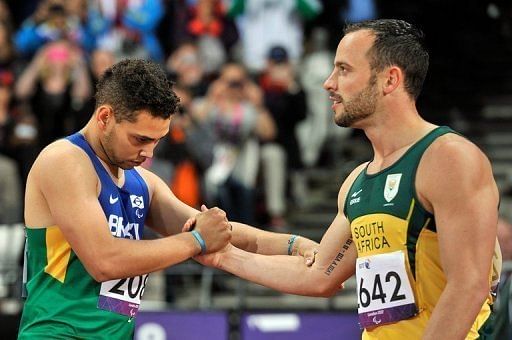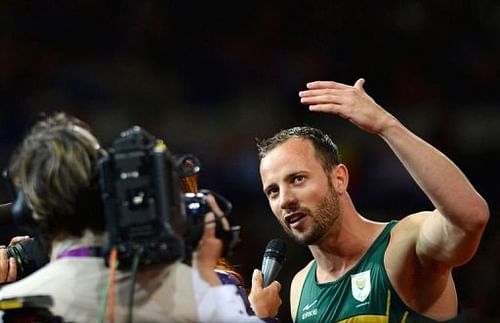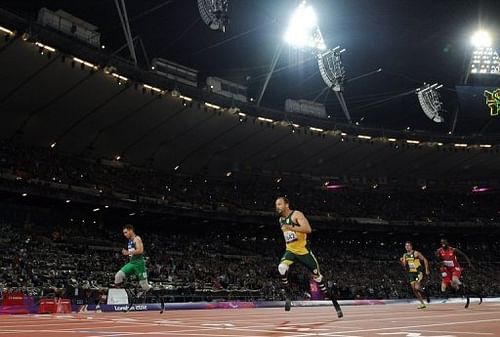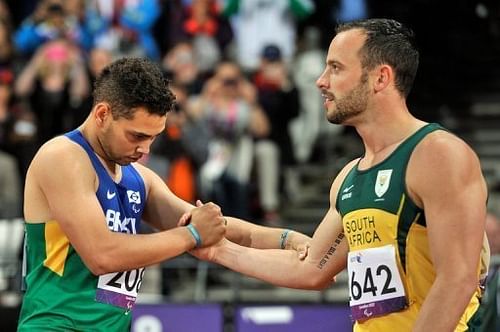
Pistorius controversy ignites Paralympics
LONDON (AFP) –

South Africa’s Oscar Pistorius speaks to journalists after finishing second in the men’s 200 metres T44 final athletics event during the London 2012 Paralympic Games. Pistorius has apologised for the timing of his outburst after losing his title, but insisted there was an issue with large prosthetics lengthening an amputee’s stride.
South Africa’s Oscar Pistorius is to meet the International Paralympic Committee (IPC) after he lost his first T44 200m race in nine years and said the length of his rivals’ carbon fibre blades was unfair.
The 25-year-old runner, the first double-amputee to run at the Olympics and the most high-profile athlete at the London Paralympics, hit out after he was beaten on the line on Sunday night by Brazil’s Alan Oliveira.
Pistorius, who runs on J-shaped “Cheetah” prostheses, complained that his fellow competitors, including Oliveira, were “a lot taller” and he was unable to compete with their stride length.
“You saw how far he (Oliveira) came back (down the home straight). We aren’t racing a fair race… The regulations allow that athletes can make themselves unbelievably high,” he said.

Brazil’s Alan Oliveira (l) sensationally beats South Africa’s Oscar Pistorius (C) in the Men’s 200m T44 final at the London 2012 Paralympic Games on September 2. Pistorius apologised Monday for the timing of his outburst after losing his T44 200m title, but insisted there was an issue with large prosthetics lengthening an amputee’s stride.
He added that he had raised the issue with the IPC but it had fallen “on deaf ears”.
His complaint came amid lingering questions about whether carbon fibre blades give amputee runners an advantage and follows Pistorius’ successful challenge of a ban against him running in non-disabled races because his blades were unfair.
IPC media and communications director Craig Spence revealed that Pistorius had telephoned him directly six weeks ago about the blade length of one of his rivals but was told there were no infringements.
The athlete was not Oliveira, he added.
Spence attributed Pistorius’ comments to the disappointment of losing his first 200m race in nine years and said the IPC was “more than willing” to hear his concerns “in a less hostile environment” than a packed Olympic Stadium.
But he added: “Since 2010 we have had rules in place whereby in international competition we measure athletes in the call room prior to a race.

South Africa’s Oscar Pistorius (R) shakes hands with Brazil’s Alan Oliveira after losing to him in the Men’s 200m T44 final at the London 2012 Paralympic Games on September 2. Pistorius has apologised for the timing of his outburst after the loss, in which he claimed it was not a fair race, but insisted there was an issue with large prosthetics lengthening an amputee’s stride.
“Last night (Sunday) we measured all eight athletes in the call room prior to competition. This was done by an international classifier. They were measured, we had the signature of the classifier and all eight were legitimate to race.”
IPC regulations stipulate the maximum length of prostheses for amputee athletes in T42 (above-the-knee), T43 (double below-the-knee) and T44 (single leg below-the knee) track races and they have to be proportionate to body length.
Upper limits for artificial leg lengths are calculated using a mathematical formula based on the length of an athlete’s arm span as well as the distance from their sternum (chest) to the tip of the affected limb or limbs.
An additional 3.5 percent of that calculation is factored in to replicate running action, where a non-disabled athlete runs on his or her toes, said IPC medical and scientific director Peter Van Der Vliet.
Van Der Vliet said it was “the best system in place” and had been approved by athletes, coaches and national federations, although he conceded that as science was constantly evolving, technology was “something we will look into”.
Pistorius later apologised for the timing of his comments, although not the substance.
“I do believe that there is an issue here and I welcome the opportunity to discuss with the IPC but I accept that raising these concerns immediately as I stepped off the track was wrong,” he said in a statement.
The controversy has become the main talking point at the Games, which started last Wednesday and run through to Sunday.
“You can’t help but see the irony of it, really,” said David James, senior lecturer at the Centre for Sports Engineering Research at Sheffield Hallam University in northern England.
“Pistorius has always insisted that his blades don’t enhance his performance, merely enable it — and now he’s arguing that this other guy’s (Oliveira) performance has been enhanced by his blades,” he told AFP.
But Spence said he did not believe the row had overshadowed the event, which this year has been a near-sell out for the first time in its 52-year history.
“Years ago when we had absolutely no media awareness and no coverage we would never have had this. It’s a sign of how far Paralympic sport has progressed and obviously we need a good resolution of the issue,” he added.